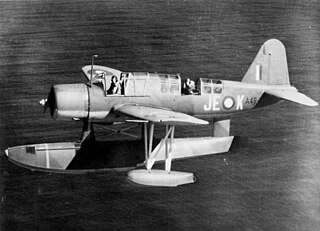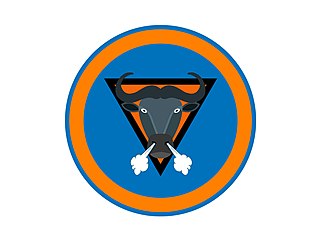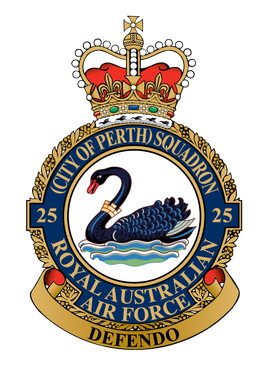Related Research Articles
The Netherlands entered World War II on May 10, 1940, when invading German forces quickly overran the country. On December 7, 1941, after the attack on Pearl Harbor, the Netherlands government in exile also declared war on Japan. Operation Market Garden, which started in 1944, liberated the southern and eastern parts of the country, but full liberation did not come until the surrender of Germany on May 5, 1945.

No. 107 Squadron was a Royal Australian Air Force maritime patrol squadron of World War II. It was formed in May 1943 and was equipped with Vought OS2U Kingfisher aircraft. The squadron conducted anti-submarine patrols off the Australian east coast during the last years of the war, but did not encounter any enemy submarines. It was disbanded in October 1945.

No. 120 Squadron was a joint Dutch and Australian squadron of World War II. The squadron was first formed in December 1943 as part of the Royal Australian Air Force (RAAF), and saw combat in and around New Guinea during 1944 and 1945 equipped with P-40 Kittyhawk fighters. Following the war, No. 120 Squadron was transferred to the Netherlands East Indies Air Force in 1946 and participated in the Indonesian National Revolution.

No. 18 Squadron was a joint Dutch and Australian bomber squadron of World War II. Formed in April 1942, the squadron was staffed by a mixture of Dutch and Australian personnel and placed under Royal Australian Air Force operational command. Initially it undertook anti-submarine patrols on the east coast of Australia, before moving to northern Australia and taking part in operations against the Japanese in the islands of the Netherlands East Indies (NEI). At the conclusion of hostilities, the squadron came under Dutch control and Australian personnel were transferred out. The squadron then undertook operations during the Indonesian National Revolution, before eventually being disbanded in July 1950 after being transferred to Indonesia.

No. 43 Squadron was a Royal Australian Air Force (RAAF) maritime patrol and mine-laying squadron that operated during World War II. Raised in early 1943, the squadron flew Catalina aircraft from bases in Queensland and the Northern Territory, flying mine-laying, convoy-protection and bombing sorties against Japanese targets in the Pacific theatre. These operations saw it operate as far north as the Chinese coast. After the conclusion of hostilities, the squadron was disbanded in mid-1946.

No. 13 Squadron is a Royal Australian Air Force (RAAF) squadron. The unit saw combat during World War II as a bomber and maritime patrol squadron and is currently active as a mixed regular and reserve RAAF unit located in Darwin, fulfilling both operational support and training duties.

No. 12 Squadron was a Royal Australian Air Force (RAAF) general purpose, bomber and transport squadron. The squadron was formed in 1939 and saw combat in the South West Pacific theatre of World War II. From 1941 to 1943, it mainly conducted maritime patrols off northern Australia. The squadron was based at Merauke in western New Guinea from November 1943 to July 1944, when it was withdrawn from operations. After being re-equipped, it operated as a heavy bomber unit from February 1945 until the end of the war. The squadron continued in this role until it was redesignated No. 1 Squadron RAAF in February 1948. The squadron was reformed in 1973 to operate transport helicopters but was again disbanded in 1989.

No. 25 Squadron is a general reserve squadron of the Royal Australian Air Force (RAAF). It is based at RAAF Base Pearce in Perth, Western Australia, and forms part of the Combat Support Group. The squadron was formed in early 1937 and until early 1939 was designated as No. 23 Squadron. During World War II, it provided local air defence for the Perth region, before undertaking Army co-operation duties in 1943–1944 and then converting to a heavy bomber role in 1945. Flying B-24 Liberators, the squadron took part in operations against Japanese targets in the Netherlands East Indies (NEI) and supported Allied ground operations during the Borneo Campaign.

No. 78 Squadron was a Royal Australian Air Force (RAAF) fighter squadron of World War II. It was formed in July 1943 as part of expansion of the RAAF's fighter force, and was assigned to mobile striking forces for the duration of the war.

The Royal Netherlands East Indies Army Air Force was the air arm of the Royal Netherlands East Indies Army in the Dutch East Indies from 1939 until 1950. It was an entirely separate organisation from the Royal Netherlands Air Force.

No. 8 Squadron was an Australian flying training squadron of World War I and medium bomber squadron of World War II. The squadron was formed in England in October 1917 as part of the Australian Flying Corps, and disbanded in April 1919. It was re-formed by the Royal Australian Air Force in September 1939. After seeing action during the Pacific War flying Lockheed Hudson and, later, DAF Beaufort bombers, the squadron was disbanded a second time in January 1946.

Merauke Force was an Australian-led military force of World War II which was responsible for defending Merauke in Dutch New Guinea from Japanese attack amidst the Pacific War. The force was established in late 1942 and was disbanded at the end of the war, having never seen combat. The Japanese attack did not eventuate and from mid-1944 the force was progressively drawn down and its assigned units redeployed to Australia or elsewhere in the Pacific. At its height, Merauke Force included troops from Australia, the Netherlands East Indies and the United States, as well as several squadrons of aircraft, including a joint Australian-Dutch fighter unit.

No. 79 Wing was a Royal Australian Air Force (RAAF) wing of World War II. It was formed in December 1943 at Batchelor, Northern Territory, as part of North-Western Area Command. Led by Group Captain Charles Eaton, the wing comprised four squadrons on its establishment, flying Beaufort and B-25 Mitchell bombers and Beaufighter heavy fighters. No. 79 Wing took part in the New Guinea and North-Western Area Campaigns during 1944–45, eventually transferring to Balikpapan in the Dutch East Indies as the Allies advanced northward. By the end of the Pacific War, the wing was attached to the Australian First Tactical Air Force and was made up of Nos. 2 and 18 Squadrons, both flying Mitchells. The latter transferred to the Netherlands Air Force in late 1945, while the former returned to Australia where it disbanded the following year. No. 79 Headquarters itself disbanded in October 1945, soon after the end of hostilities.

No. 72 Wing was a Royal Australian Air Force (RAAF) wing that operated during World War II. It was formed in April 1943 at Townsville, Queensland, as part of North-Eastern Area Command. Led by Group Captain Charles Eaton, the wing soon deployed to Merauke, Dutch New Guinea, where it comprised three squadrons flying CAC Boomerang and P-40 Kittyhawk fighters, and A-31 Vengeance dive bombers. Eaton was succeeded by Group Captain Allan Walters in mid-1943. No. 72 Wing took part in the defence of Torres Strait, undertaking interception, patrol and occasional ground-attack and anti-shipping duties. By July 1944, its original squadrons had all been disbanded or transferred to other operational formations. No. 120 Squadron, which had arrived in May 1944, operating Kittyhawks, remained at Merauke until February 1945. The wing headquarters returned to Australia that May, and disbanded the following month.

No. 61 Wing was a Royal Australian Air Force (RAAF) airfield construction wing of World War II. The wing was formed in January 1943 and was disbanded in November 1945. During the war, No. 61 Wing and the units under its command served in the North Western Area and South West Pacific Area (SWPA) and played a significant role in supporting RAAF and United States Army Air Forces (USAAF) operations.

RAAF Command was the main operational arm of the Royal Australian Air Force (RAAF) during World War II. The command was formed in September 1942 and by April 1943 comprised 27 squadrons, including units from the Netherlands, the United Kingdom and the United States, as well as Australia. Coming under the operational authority of Allied Air Forces Headquarters in the South West Pacific Area, RAAF Command exercised control of its units through geographically based area commands in Australia and, later, New Guinea, as well as large mobile formations including the Australian First Tactical Air Force. The command reached a strength of 41 squadrons in October 1944. From the time of its establishment, until its disbandment in September 1945, it was led by Air Vice Marshal Bill Bostock.
120 Squadron was a Netherlands East Indies Air Force unit which was later re-raised part of the Royal Netherlands Air Force. The squadron was first formed in December 1943 as part of the Royal Australian Air Force (RAAF), and saw combat in and around New Guinea during 1944 and 1945 equipped with P-40 Kittyhawk fighters. No. 120 Squadron was transferred to the Netherlands East Indies Air Force in 1946 and attacked Indonesian forces during the Indonesian National Revolution. It was disbanded in 1950 as a result of the Dutch–Indonesian Round Table Conference, but was re-formed in 1961 as an air defence unit. 120 Squadron was disbanded in 1983.
19 Squadron ML-KNIL, also known as No. 19 Squadron RAAF, was a transport and communications unit of the Royal Netherlands East Indies Army Air Force (MK-KNIL), formed in Australia during the final stages of World War II. The squadron was formed as a Dutch unit in late 1944 from two transport flights that had previously been based in Brisbane and Melbourne, and which had run supplies to joint Australian-NEI combat squadrons in the Northern Territory and in West Papua. Upon formation the squadron was based at Archerfield, near Brisbane. In 1945, it was transferred to the Royal Australian Air Force (RAAF), but returned to Dutch control in 1947 and subsequently took part in operations during the Indonesian National Revolution.

North-Western Area Command was one of several geographically based commands raised by the Royal Australian Air Force (RAAF) during World War II. Its wartime sphere of operations included the Northern Territory, adjacent portions of Queensland and Western Australia, and the Dutch East Indies. The command was formed in January 1942, following the outbreak of the Pacific War, from the western part of Northern Area Command, which had covered all of northern Australia and Papua. Headquartered at Darwin, North-Western Area Command was initially responsible for air defence, aerial reconnaissance and protection of the sea lanes within its boundaries.

The Free Dutch Forces refers to the Dutch military formations of the Dutch government-in-exile and its colonies that were formed to fight alongside the Western Allies against Nazi Germany and its allies during World War II following the Dutch surrender in May 1940.
References
- Citations
- ↑ "RAAF Squadron Codes". Encyclopedia. Australian War Memorial. Retrieved 29 January 2011.
- 1 2 3 4 RAAF Historical Section (1995), p. 105
- ↑ "No. 18 (NEI) Squadron, RAAF". Allies in Adversity. Australia and the Dutch in the Pacific War. Australian War Memorial. Retrieved 29 January 2011.
- 1 2 Palazzo, Albert. "The Netherlands East Indies and the Pacific War". Allies in Adversity. Australia and the Dutch in the Pacific War. Australian War Memorial. Retrieved 29 January 2011.
- Bibliography
- RAAF Historical Section (1995). Units of the Royal Australian Air Force. Volume 3: Bomber Units. Canberra: Australian Government Publishing Service. ISBN 0-644-42795-7.